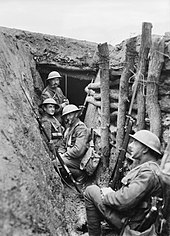The Royal Fusiliers (City of London Regiment)
The Royal Fusiliers (City of London Regiment) (until 1881 7th Foot The Royal Regiment of Fusiliers , originally The Ordnance Regiment ) was an infantry unit of the British Army . The regiment was set up in 1685 to protect the artillery and was housed in the Tower of London . It fought in almost all of Britain's wars and was merged with other regiments to form the Royal Regiment of Fusiliers in 1968 .
history
1685 established the Feldzeugmeister ( Master-General of the Ordnance ) and constable of the Tower George Legge, 1st Baron Dartmouth the association as The Ordnance Regiment for the protection of the artillery . The regiment was the first in the English army, the flintlock rifles ( fusil ), as in the formerly standard Luntenschlossmusketen the risk of accidental ignition of gunpowder stocks of artillery was. It was therefore soon given the name Royal Regiment of Fusiliers. At the beginning of the 18th century, the flintlock musket was introduced in the entire army, so that the unique selling point actually disappeared, but the name was retained. However, the mission and equipment were identical to the rest of the line infantry . Some infantry regiments that were set up later (e.g. the 21st and 23rd regiments) were given the name Fusiliers as an award without reference to the original order of artillery guard. In the late 18th century, all companies of the fusilier regiments received fur hats as recognition, while in the other line infantry only the grenadier companies were equipped with them. However, the hats were slightly lower than the grenadier hat . As a regiment with a royal title in its name ( Royal ), it had blue as its badge color . During the First World War, the five battalions No. 38 to 42 belonged to the regiment as the Jewish Legion . In 1968 it was merged with three other fusilier regiments to form the Royal Regiment of Fusiliers .
The headquarters and regimental museum are still in the tower after the merger.
Stakes and battle honors
The regiment fought with distinction in almost all of Britain's wars, including the American Revolutionary War , the Napoleonic Wars , the Crimean War, and both World Wars .
It was allowed to lead the following battle honors on the flag:
- 17th to 19th centuries: Namur 1695, Martinique 1809, Talavera, Busaco, Albuhera, Badajoz, Salamanca, Vittoria, Pyrenees, Orthes, Toulouse, Peninsula, Alma, Inkerman, Sevastopol, Kandahar 1880, Afghanistan 1879–80, Relief of Ladysmith , South Africa 1899-1902
- First World War : Mons, Le Cateau, Retreat from Mons, Marne 1914, Aisne 1914, La Bassée 1914, Messines 1914 '17, Armentières 1914, Ypres 1914 '15 '17 '18, Nun Bosschen, Gravenstafel, St. Julien, Frezenberg, Bellewaarde, Hooge 1915, Loos, Somme 1916 '18, Albert 1916 '18, Bazentin, Delville Wood, Pozières, Flers-Courcelette, Thiepval, Le Transloy, Ancre Heights, Ancre 1916 '18, Arras 1917 '18, Vimy 1917, Scarpe 1917, Arleux, Pilckem, Langemarck 1917, Menin Road, Polygon Wood, Broodseinde, Poelcappelle, Passchendaele, Cambrai 1917 '18, St. Quentin, Bapaume 1918, Rosières, Avre, Villers Bretonneux, Lys, Estaires, Hazebrouck, Béthune, Amiens, Drocourt-Quéant, Hindenburg Line, Havrincourt, Épéhy, Canal du Nord, St. Quentin Canal, Beaurevoir, Courtrai, Selle, Sambre, France and Flanders 1914–18, Italy 1917–18, Struma, Macedonia 1915–18, Helles, Landing at Helles, Krithia, Suvla, Scimitar Hill, Gallipoli 1915-16, Egypt 1916, Megiddo, Nablus, Palestine 1918, Troitsa, Archangel 1919, Kilimanj aro, Behobeho, Nyangao, East Africa 1915-17
- Second World War : Dunkirk 1940, North-West Europe 1940, Agordat, Keren, Syria 1941, Sidi Barrani, Djebel Tebaga, Peter's Corner, North Africa 1940 '43, Sangro, Mozzagrogna, Caldari, Salerno, St. Lucia, Battipaglia, Teano, Monte Camino, Garigliano Crossing, Damiano, Anzio, Cassino II, Ripa Ridge, Gabbiano, Advance to Florence, Monte Scalari, Gothic Line, Coriano, Croce, Casa Fortis, Savio Bridgehead, Valli di Commacchio, Senio, Argenta Gap, Italy 1943– 45, Athens, Greece 1944-45
- Post-war period: Korea 1952–53
Namesake
literature
- John Percy Groves, Richard Cannon, GH Waller: Historical Records of the 7th Or Royal Regiment of Fusiliers: Now Known as the Royal Fusiliers (the City of London Regiment), 1685-1903. FB Guerin, Guernsey 1903, OCLC 5767361 .
